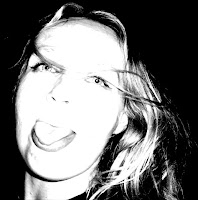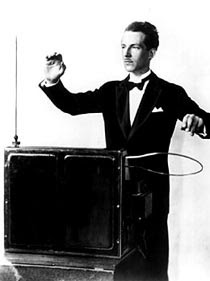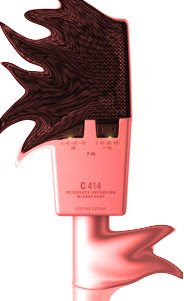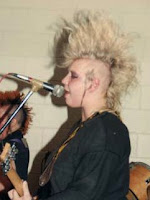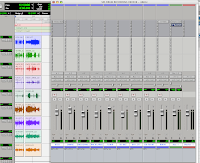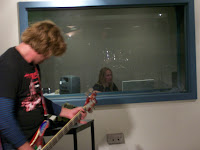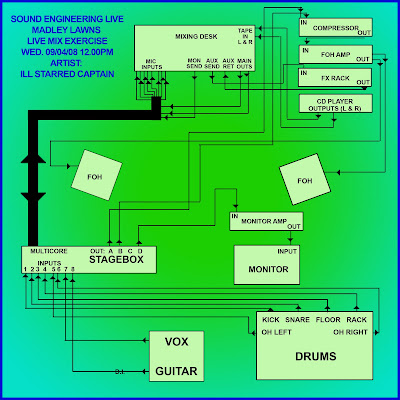
(This diagram represents a model of my ideal set-up for this gig):
As a live mixing exercise, the Madley Lawns gig of April 9 was an interesting starting point for the class. Outdoor live gigs that require sound reinforcement often have their own special set of problems, apart from the usual technical necessities of any live amplification situation.
It seemed that everyone in the group took on a number of roles that day, including setting-up, routing signals and mixing, and it was good to see them liaising confidently and politely with the band,
The featured artist on the day was two-piece Ill Starred Captain, whose line-up consisted of Scott on acoustic guitar and vocals and Jason on drums. From all accounts Ill Starred Captain are an experienced live and touring music duo and this was apparent in their organisation: they were quick to set up and had all the necessary equipment with them (including gaffer tape which none of us had thought to bring). Scott had his own DI box with him, which gave us a send directly from the guitar to the stage box without need for further miking. For his vocals, we used a Shure SM58 which ran into the stage box also.
Jason’s drums were mic’d as follows (he used only one rack tom):
KICK – SHURE BETA 52
SNARE – SHURE SM-57
RACK – SHURE SM-57
FLOOR – SHURE BETA 56
OVERHEAD LEFT – RODE NT-5
OVERHEAD RIGHT – RODE NT-5
All the microphone leads from this array fed directly into the stage box.
From the stage box, a bi-directional multicore took the microphone sends over the lawns to the mixing desk. From the mixing desk, Dave ran the main outs directly into the compressor and the compressor outputs in turn went back (via the multicore) to the stage box (A and B sends). The A and B sends were then routed from the stage box to the FOH amp, the outputs of which were fed into the FOH speakers.
A monitor send was taken from the desk via the multicore (D send) back to the stage box and thence to the monitor amp (which was up on the stage). The output of the monitor amp was then fed into the monitor speaker which was positioned between and facing the performers.
An auxiliary send was set up straight from the desk into the reverb unit, from which a return was sent back to the desk, enabling us to apply a little sweetening reverb to the vocals.
Finally, a CD player was plugged directly into the mixing desk (via aux returns as there was no "tape in") to provide music to start and end the set.
I thought the sound quality was good except that there were obvious issues with the overhead microphones picking up wind noise as it was a breezy day. We placed wind socks over the mics which helped but did not entirely eliminate the problem. Scott complained initially that he wasn’t getting much in the way of vocal foldback but this was quickly rectified by turning up the send from his vocal mic to the monitor bus. Also, when we recreated this set-up in the studio after the fact, the signal path was slightly different in that, instead of the compressor getting a signal straight from the desk before returning to the multicore, we set it up so that the signal went to the compressor from the desk outputs via the multicore. Dave said this was a better system anyway but I’m not sure why.
Given the size of the act and the space they were performing in, miking up the drums so comprehensively was possibly a redundancy but it was good in the context of the learning exercise.
All in all, a good day’s work – it was only a shame to see it cut short!
